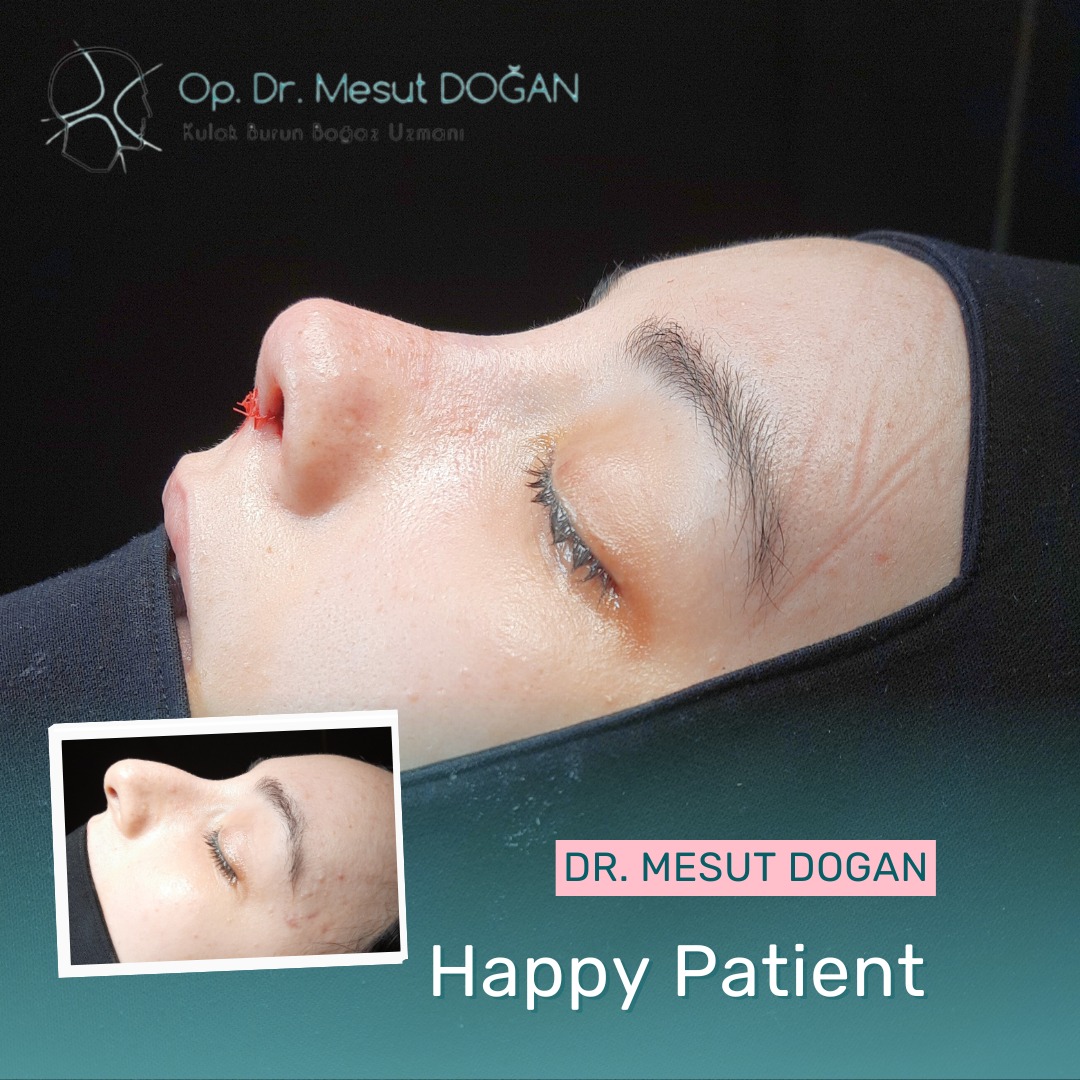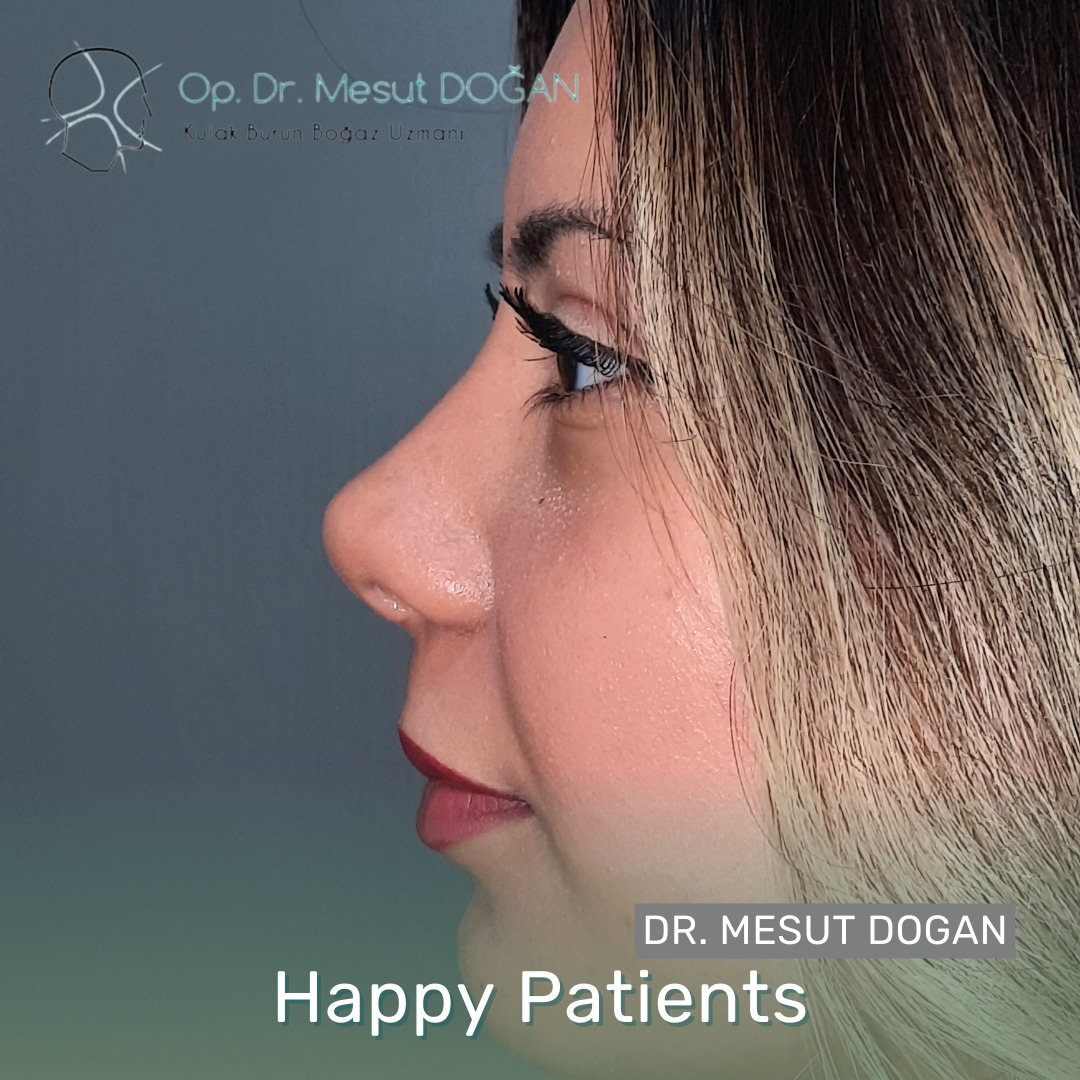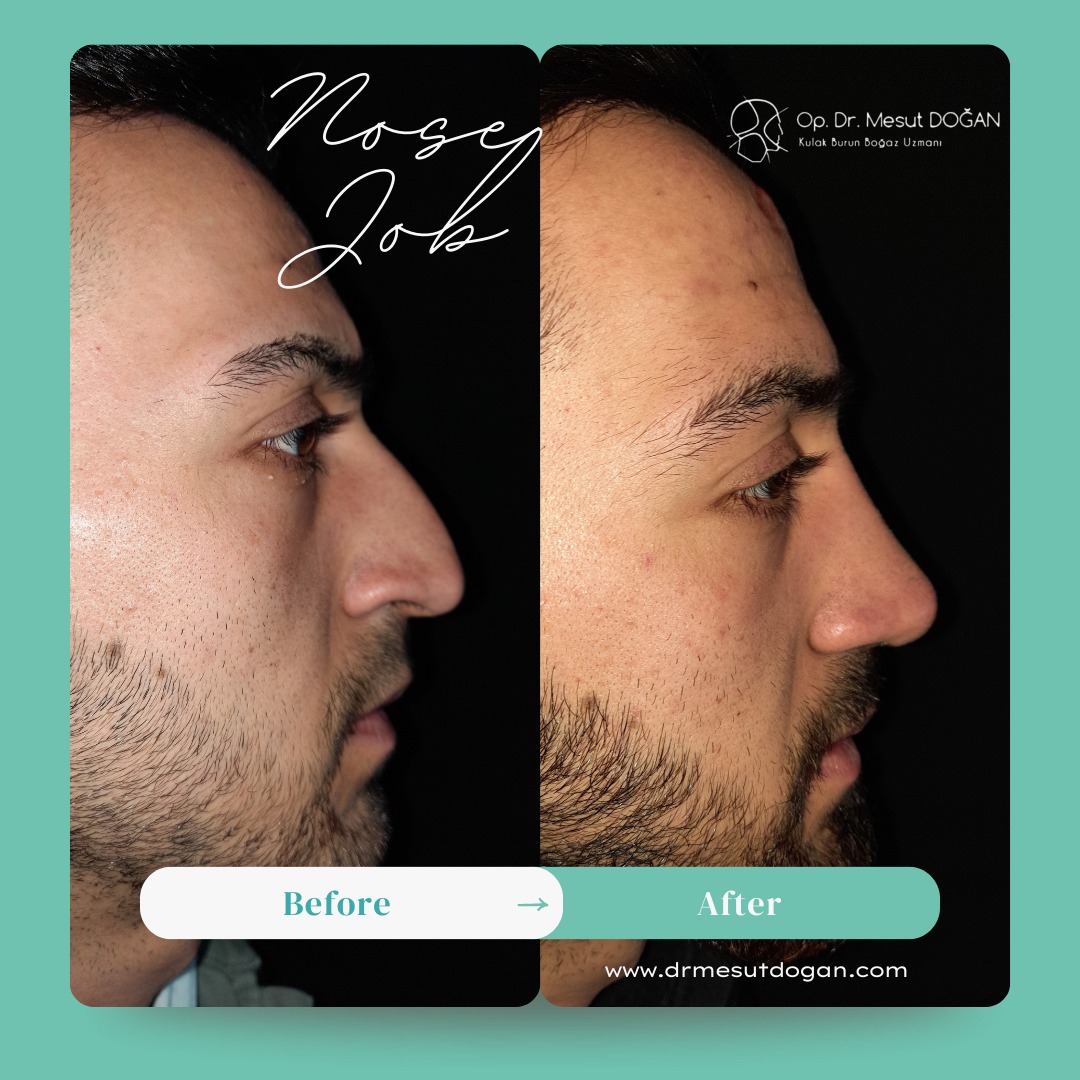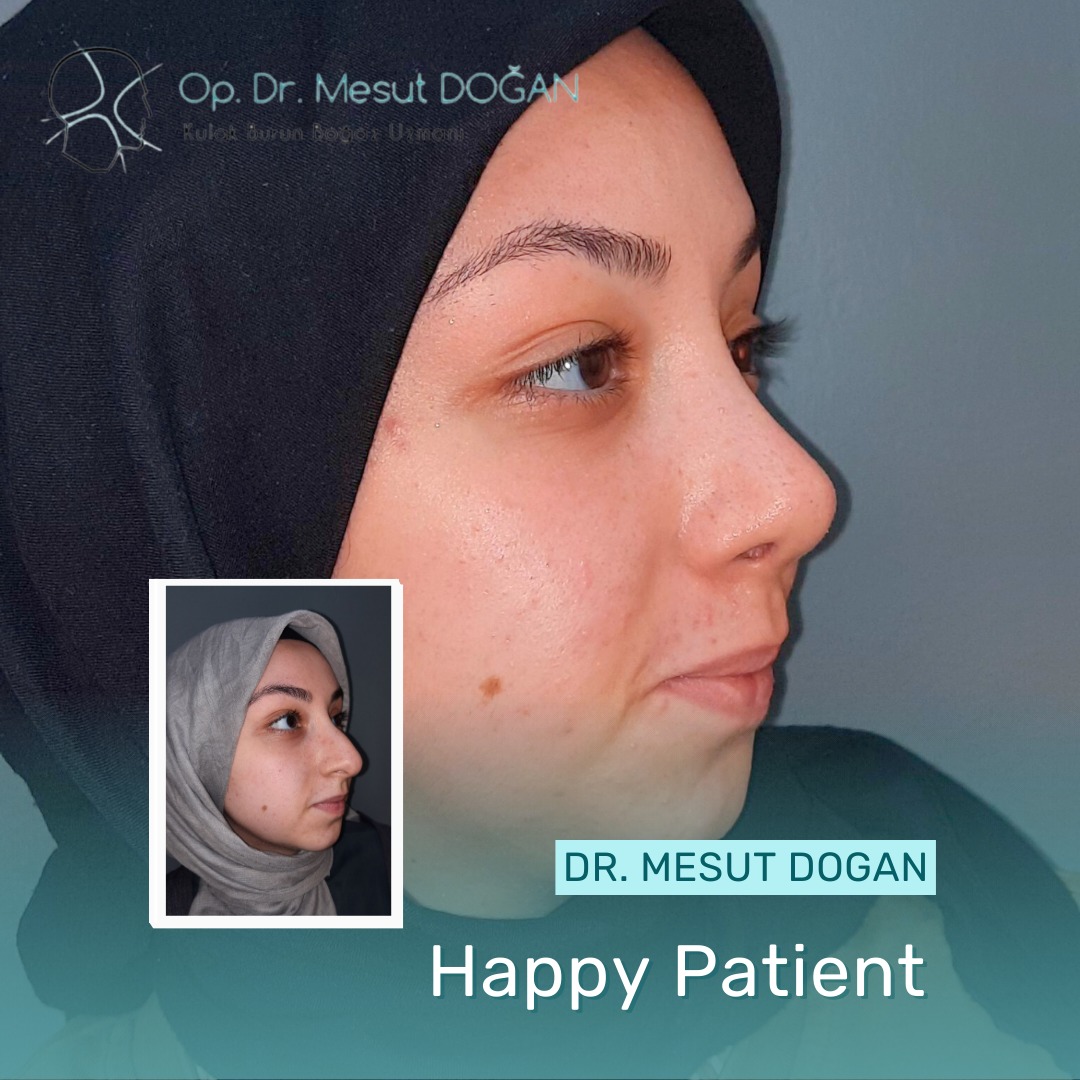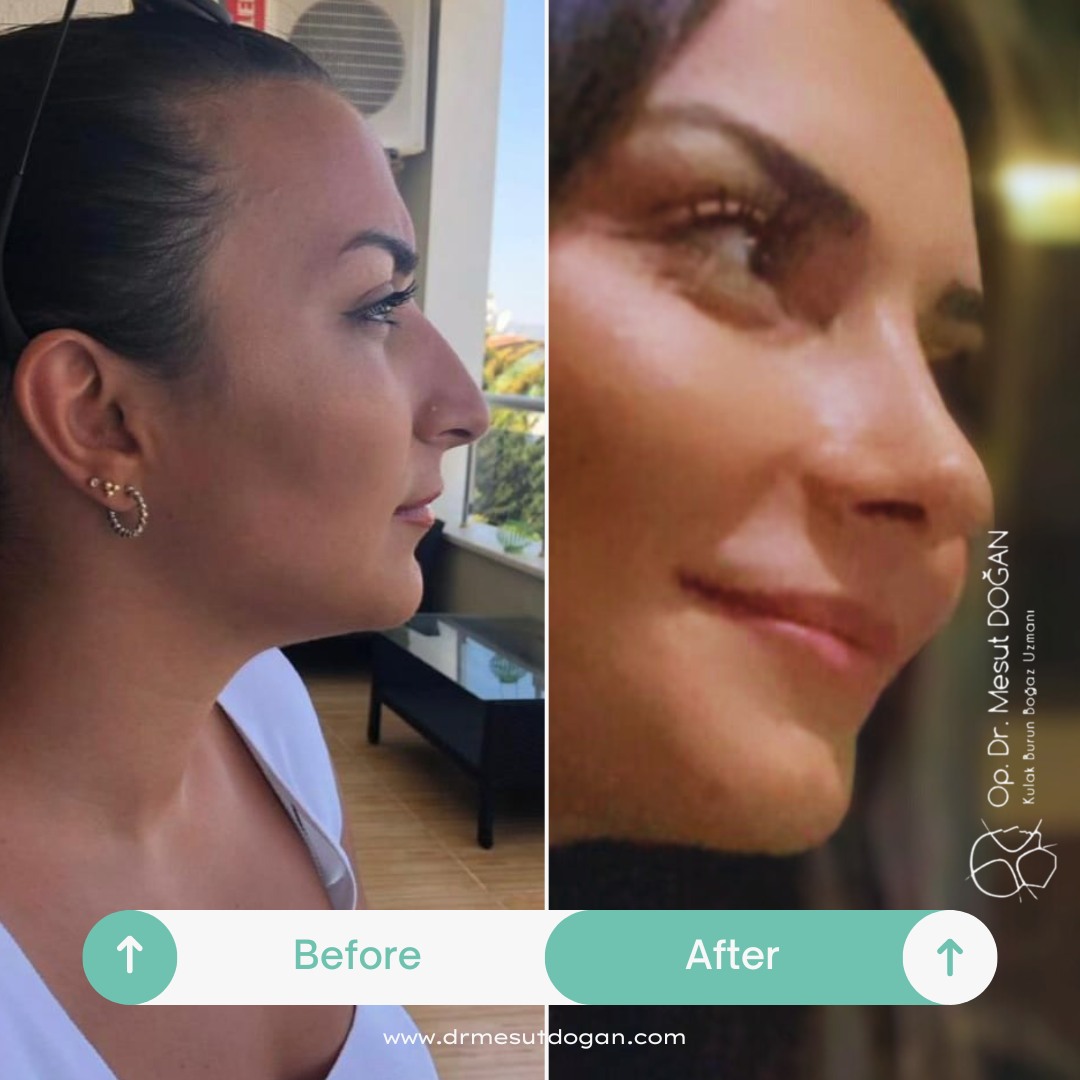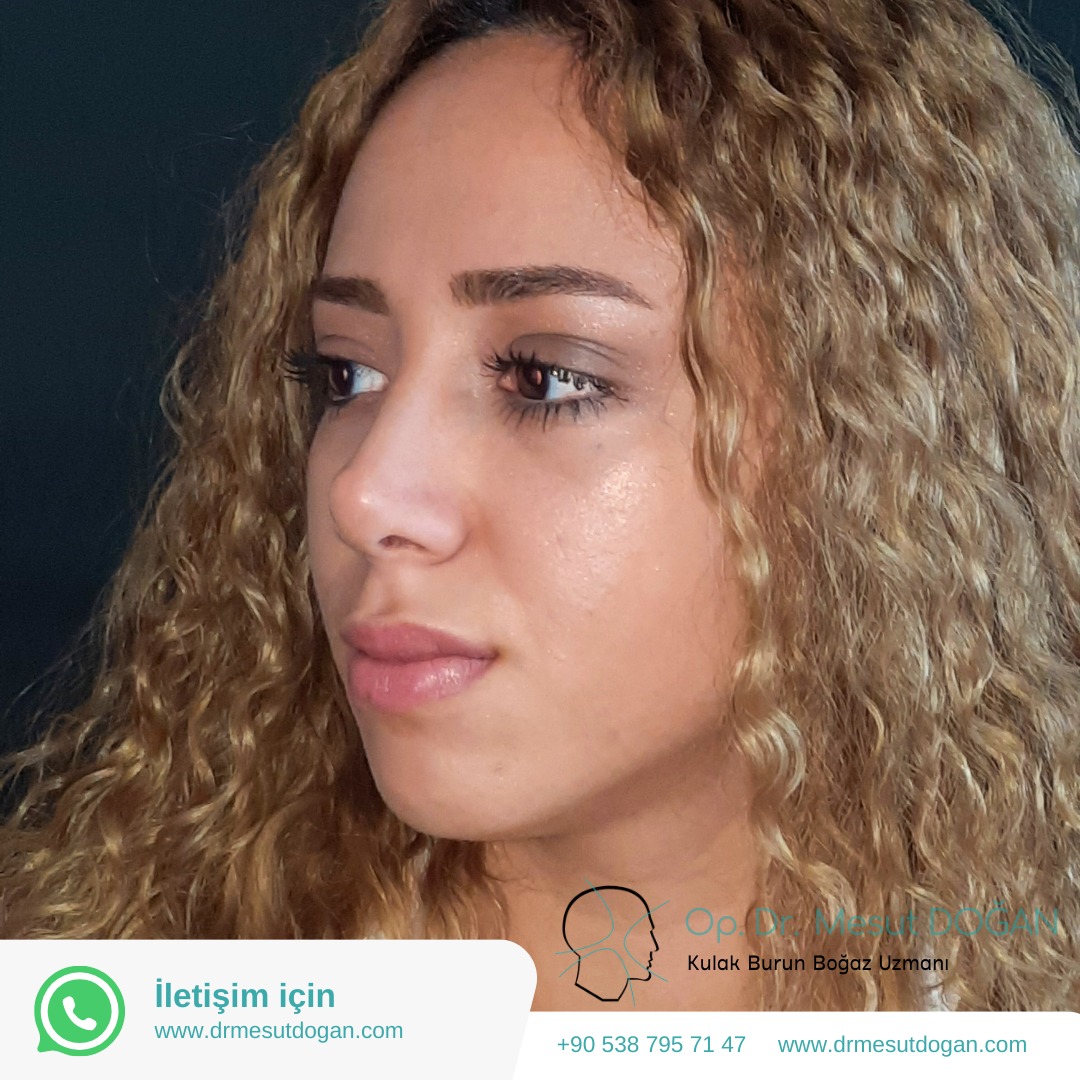Rhinoplasty in Turkey with Follow-up Aftercare in London
Expert Turkish Rhinoplasty with London Consultation Convenience
5,000+ Procedures | 20 Years Experience
Ultrasonic Piezo Technology
Pre & Post-Op London Consultations
Rhinoplasty In Turkey, Istanbul: World-Class Turkish Expertise with London Accessibility
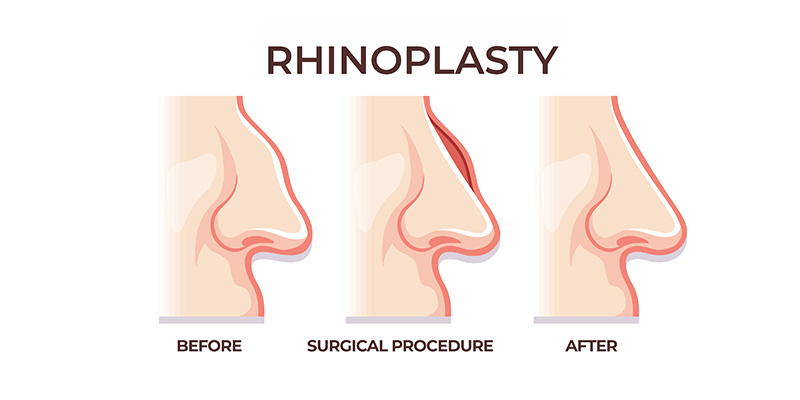
Dr. Mesut Dogan is internationally recognized as one of the best rhinoplasty surgeons in Turkey, bringing over 20 years of specialized experience and having successfully completed more than 5,000 rhinoplasty procedures at his advanced Istanbul clinic. His expertise in rhinoplasty Istanbul techniques, enhanced by cutting-edge ultrasonic piezo technology, has attracted thousands of international patients from Europe, the Middle East, and the UK—all seeking the precision, natural results, and affordability that Turkish rhinoplasty has become renowned for worldwide.
What sets Dr. Dogan apart is not just his surgical mastery developed over two decades, but his understanding of the unique needs of international patients. For London residents seeking rhinoplasty in Istanbul, Turkey, the journey often feels daunting—multiple trips abroad, unfamiliar healthcare systems, and concerns about follow-up care. Dr. Dogan has revolutionized this experience by bringing his expertise directly to London through comprehensive consultation services, creating a seamless bridge between British convenience and Turkish surgical excellence.
Rhinoplasty Istanbul represents far more than just an affordable alternative to UK private clinics. It embodies a surgical philosophy refined over 20 years, where precision meets artistry, and where surgeons perform hundreds of procedures annually—developing an intuitive understanding of nasal aesthetics that only comes from extensive, focused experience. Dr. Dogan's 5,000+ procedures span every complexity level, from subtle refinements to comprehensive reconstructions, each contributing to the refined judgment and technical mastery he brings to every patient consultation.
The growing demand for rhinoplasty in Istanbul, Turkey among London patients reflects a broader recognition: that expertise isn't defined by geography, but by skill, experience, and commitment to natural-looking results. Dr. Dogan's integrated London-Istanbul model eliminates the traditional barriers of international medical travel while preserving all the advantages—world-class surgical standards enhanced by ultrasonic piezo precision, personalized care, and the transformative confidence that comes from achieving your aesthetic goals with a surgeon who truly understands your vision.
Why Rhinoplasty Istanbul Has Become the Choice for London Patients
Rhinoplasty in Istanbul, Turkey has emerged as a global destination for nasal surgery, attracting over 50,000 international patients annually. This remarkable growth isn't coincidental—it reflects Istanbul's unique combination of surgical excellence, advanced medical infrastructure including ultrasonic piezo technology, and cost advantages that make world-class rhinoplasty accessible to patients who might find UK private clinic prices prohibitive.
London patients choosing rhinoplasty Istanbul benefit from several compelling factors. Turkish surgeons, including Dr. Dogan with his 20 years of experience, typically perform significantly higher surgical volumes than their UK counterparts—this concentrated experience translates directly to refined technique, better complication management, and more predictable outcomes. When a surgeon completes 200-300 rhinoplasty procedures annually versus 30-50, and has accumulated over 5,000 lifetime procedures, the expertise differential becomes substantial.
The best rhinoplasty surgeons in Turkey have gained international recognition for their innovative techniques, including advanced ultrasonic piezo technology, and natural-looking results. Turkish rhinoplasty philosophy emphasizes facial harmony over standardized ideals, respecting individual characteristics while achieving desired aesthetic refinement. This approach resonates particularly well with London's diverse population, where patients seek surgeons who understand varied facial structures and cultural aesthetic preferences.
Beyond surgical expertise, Dr. Dogan's practice offers a unique advantage through London-based consultations, eliminating the uncertainty many patients feel about committing to surgery abroad without first meeting their surgeon face-to-face. This integrated approach combines rhinoplasty Istanbul's world-class surgical standards with the convenience and reassurance of local consultation and follow-up care—creating a truly seamless international treatment experience.
The 5,000+ Procedure Difference: 20 Years of Surgical Excellence
Successful Procedures
Years Experience
When evaluating the best rhinoplasty surgeon in Turkey, both surgical volume and years of dedicated practice represent the most reliable indicators of expertise. Dr. Dogan's 5,000+ completed rhinoplasty procedures over 20 years demonstrate a level of hands-on experience that directly correlates with superior outcomes. This isn't merely about quantity—it's about the pattern recognition, surgical judgment, and technical refinement that only develops through extensive, focused practice spanning two decades.
Each rhinoplasty presents unique challenges: varied nasal anatomy, different skin thickness, individual healing characteristics, and diverse aesthetic goals. Surgeons who perform hundreds of procedures annually for 20 years develop an intuitive understanding of these variables that cannot be taught in textbooks or replicated through limited practice. Dr. Dogan's 5,000+ procedures encompass every complexity level, from straightforward aesthetic refinements to challenging revision cases requiring sophisticated reconstructive techniques with ultrasonic piezo precision.
Experience Translates to Measurable Advantages for Rhinoplasty Istanbul Patients
Advanced Pattern Recognition
Immediate assessment of nasal structure and optimal surgical approach based on thousands of previous cases across 20 years
Complication Prevention
Anticipating and avoiding potential issues through extensive procedural experience refined over two decades
Revision Expertise
Deep understanding of previous surgical alterations when performing secondary rhinoplasty, enhanced by ultrasonic piezo precision
Outcome Prediction
Realistic assessment of achievable results based on individual anatomical factors and 20 years of diverse cases
Technical Mastery
Refined surgical movements and tissue handling developed through 5,000+ repetitive procedures and continuous technique evolution
Aesthetic Judgment
Intuitive understanding of facial proportions and natural-looking enhancement refined over 20 years of dedicated practice
For London patients considering rhinoplasty in Istanbul, Turkey, Dr. Dogan's extensive 20-year track record and 5,000+ procedures provide confidence that their surgery will be performed by a specialist who has successfully navigated virtually every nasal structure, aesthetic challenge, and surgical complexity. This proven experience, combined with his commitment to ongoing education and cutting-edge ultrasonic piezo technology, ensures that patients receive surgical care reflecting the highest standards of rhinoplasty Istanbul expertise.
Your Rhinoplasty Istanbul Journey: From London Consultation to Final Results
Dr. Dogan's innovative London-Istanbul treatment model, refined over 20 years of international patient care, transforms the traditional medical tourism experience into a seamless, well-supported journey. Understanding that international patients need both accessibility and continuity of care, this integrated approach addresses every stage of your rhinoplasty experience—from initial consultation through long-term follow-up.
Stage 1: London Consultation and Treatment Planning
Your rhinoplasty Istanbul journey begins in familiar surroundings with a comprehensive London consultation. During this detailed evaluation, Dr. Dogan performs thorough nasal examination, facial proportion analysis, and assessment of breathing function, ensuring clear communication about aesthetic goals and realistic expectations.
The London consultation eliminates uncertainty about committing to surgery abroad. You meet your surgeon face-to-face, ask questions in person, and receive detailed treatment planning before making any international travel arrangements. This personal connection, built on Dr. Dogan's 20 years of patient care experience, establishes trust and confidence that remote consultations simply cannot replicate.
What's Included: 60-90 minute consultation • Comprehensive nasal examination • Detailed written treatment plan • Pre-operative preparation guidance • All your questions answered
Stage 2: Rhinoplasty Procedure in Istanbul
Once you've decided to proceed, your rhinoplasty Istanbul procedure takes place in state-of-the-art surgical facilities meeting international healthcare standards. These modern hospitals feature advanced surgical equipment including ultrasonic piezo technology, experienced medical teams, and comprehensive safety protocols ensuring the highest quality care.
Pre-operative medical examinations and final consultations occur the day before surgery, confirming all preparations and addressing any last-minute questions. The surgical procedure itself utilizes advanced open rhinoplasty techniques with ultrasonic piezo precision, allowing precise structural modifications and optimal aesthetic refinement.
Dr. Dogan's meticulous approach, refined over 20 years and 5,000+ procedures, emphasizes natural-looking results that enhance facial harmony while maintaining proper nasal function. Surgery typically requires 2-4 hours depending on complexity, performed under general anesthesia with board-certified anesthesiologists ensuring patient safety and comfort throughout.
Istanbul Process: Dr. Dogan will share comprehensive details about your Istanbul surgical journey during your London consultation, including hospital procedures, recovery timeline, and all necessary arrangements • Typically 5-7 days total stay
Stage 3: Recovery and London Follow-Up Care
Returning to London doesn't mean losing access to your surgeon's expertise. Dr. Dogan maintains ongoing communication throughout your recovery, available for questions or concerns as healing progresses. London-based follow-up consultations can be scheduled at key recovery milestones—typically at 1 month, 3 months, 6 months, and 1 year post-surgery.
These in-person follow-up appointments provide valuable reassurance during the recovery process, allowing Dr. Dogan to assess healing progress, address any concerns, and ensure results develop as planned. This continuity of care represents a significant advantage over traditional medical tourism, where patients often struggle to access their surgeon after returning home.
The complete rhinoplasty Istanbul recovery timeline spans approximately 12 months, though most patients return to normal activities within 2-3 weeks. Initial swelling subsides substantially within the first month, with continued refinement occurring gradually over the following year. Dr. Dogan's comprehensive aftercare guidance, informed by 20 years of patient experience, ensures you understand what to expect at each recovery stage, promoting optimal healing and long-term satisfaction with your rhinoplasty results.
Recovery Support: London follow-ups at 1, 3, 6, 12 months • Ongoing communication with Dr. Dogan • Comprehensive aftercare guidance • Return to work: 1-2 weeks • Major swelling subsides: 4-6 weeks • Final results: 12 months
🌉 The London-Istanbul Bridge: World-class surgery with hometown convenience – a unique advantage only Dr. Dogan offers for rhinoplasty in Istanbul, Turkey, refined over 20 years of international patient care
Understanding Open Rhinoplasty Techniques in Istanbul
Dr. Dogan exclusively performs open rhinoplasty techniques for rhinoplasty Istanbul procedures, utilizing advanced ultrasonic piezo technology alongside traditional surgical methods to achieve optimal aesthetic and functional outcomes. This combination of open visualization and precision piezo instruments, refined over 20 years and 5,000+ procedures, provides superior control, minimizes tissue trauma, and delivers more predictable, natural-looking results—particularly for complex cases and patients seeking significant structural refinement.
Open rhinoplasty involves a small, discrete incision at the columella (the tissue between the nostrils), allowing complete access to the underlying nasal structures. The addition of ultrasonic piezo technology enables precise bone reshaping without affecting surrounding soft tissues, cartilage, or blood vessels—resulting in reduced swelling, faster recovery, and exceptional surgical precision. The resulting columellar scar typically heals to near-invisibility within months, making any aesthetic trade-off negligible compared to the surgical advantages gained.
Ultrasonic Piezo Rhinoplasty Technology
Dr. Dogan's rhinoplasty Istanbul practice incorporates cutting-edge ultrasonic piezo instruments that revolutionize nasal bone reshaping with unparalleled precision and safety.
Selective Bone Cutting
Piezo technology only cuts bone, preserving delicate soft tissues, cartilage, and blood vessels for minimal trauma
Reduced Swelling
Minimal tissue trauma results in significantly less post-operative bruising and swelling compared to traditional methods
Faster Recovery
Precise cutting reduces healing time, allowing patients to return to normal activities sooner
Millimeter Precision
Ultrasonic vibrations enable controlled bone reshaping with accuracy impossible using traditional instruments
🔍 Why Dr. Dogan Chooses Open Rhinoplasty with Ultrasonic Piezo for Istanbul Procedures
Superior Visualization + Precision Technology
Direct, unobstructed view of all nasal structures combined with ultrasonic piezo precision allows for millimeter-level accuracy in bone reshaping, reducing surgical uncertainty and improving outcome predictability beyond what's possible with closed techniques or traditional instruments.
Minimal Tissue Trauma, Natural Results
Piezo technology's selective cutting preserves delicate nasal tissues, blood vessels, and cartilage, resulting in less post-operative swelling, faster healing, and more natural-looking outcomes. This is particularly important for achieving refined, elegant results without the over-operated appearance.
Optimal for Complex Cases and Revisions
Essential for revision rhinoplasty, significant structural changes, and cases requiring extensive cartilage grafting or functional correction. The combination of open access and piezo precision, refined through Dr. Dogan's 20 years of experience, enables addressing challenging anatomical issues that would be difficult or impossible with other approaches.
Better Symmetry and Predictable Outcomes
Direct visualization allows surgeons to assess symmetry in real-time while ultrasonic piezo enables precise, controlled adjustments—reducing revision rates and improving patient satisfaction. This advanced approach has become the gold standard for rhinoplasty in Istanbul, Turkey among leading surgeons.
Advanced Open Rhinoplasty Techniques Used in Dr. Dogan's Practice
Structural Open Rhinoplasty with Piezo
Focuses on rebuilding or reshaping the nose using cartilage grafts combined with ultrasonic piezo bone reshaping to enhance structural support and definition. Ideal for patients requiring significant tip refinement, dorsal augmentation, or correction of previous surgical complications. This approach creates a stable, long-lasting nasal structure that maintains its shape over time with minimal trauma to surrounding tissues.
Reduction Open Rhinoplasty with Ultrasonic Precision
Removes excess bone or cartilage to reduce nasal size, utilizing piezo technology for dorsal hump correction or tip refinement. This technique requires precise measurements and conservative tissue removal to avoid over-reduction—a common complication that necessitates revision surgery. Dr. Dogan's 20 years of experience with ultrasonic piezo approach ensures balanced reduction while maintaining nasal function and minimizing post-operative swelling.
Augmentation Open Rhinoplasty
Adds volume or projection using cartilage grafts, often for flat bridges or under-projected tips. Dr. Dogan's approach emphasizes natural proportion and refined elegance—achieving sophisticated nasal profiles that enhance facial harmony without exaggeration. Ultrasonic piezo technology ensures precise recipient site preparation for optimal graft placement and long-term stability.
Functional Open Rhinoplasty
Corrects internal nasal issues such as deviated septum or airway obstruction while allowing precise reconstruction. Many patients seeking rhinoplasty Istanbul discover they have functional breathing issues alongside aesthetic concerns. The open approach with piezo technology enables simultaneous correction of both, ensuring optimal long-term outcomes with minimal recovery time.
Revision Open Rhinoplasty with Ultrasonic Piezo
Used in complex secondary surgeries where visibility and precision are critical to correct or rebuild previously altered structures. Revision cases represent some of the most challenging rhinoplasty procedures, often requiring advanced grafting techniques and extensive experience. Dr. Dogan's 5,000+ procedures over 20 years include substantial revision work with ultrasonic piezo technology, providing the expertise necessary for successful secondary surgery outcomes with reduced trauma and faster recovery.
📌 Important Note: Dr. Dogan's exclusive focus on open rhinoplasty with advanced ultrasonic piezo technology reflects his commitment to achieving the highest possible standards for rhinoplasty in Istanbul, Turkey. This specialized approach, combining superior visualization with cutting-edge precision instruments and 20 years of refinement, ensures that patients receive surgical care optimized for safety, natural results, and long-term satisfaction—distinguishing his practice among the best rhinoplasty surgeons in Turkey.
Barbie Nose Istanbul: Achieving Refined, Elegant Nasal Aesthetics
Sophisticated Refinement with Natural Harmony
The "barbie nose Istanbul" aesthetic represents a refined, elegant nasal profile characterized by delicate tip projection, smooth contours, and feminine grace. Dr. Dogan's approach to achieving this sought-after look, refined over 20 years and 5,000+ procedures, emphasizes personalized refinement that enhances your natural beauty while maintaining facial harmony and proper nasal function—creating results that appear timeless rather than trendy.
When London patients request "barbie nose Istanbul" procedures, they're seeking sophisticated nasal refinement that creates an elegant, feminine appearance. Dr. Dogan specializes in achieving these refined aesthetics through advanced open rhinoplasty techniques combined with ultrasonic piezo technology, ensuring results that enhance your individual features rather than imposing standardized ideals.
The key to successful barbie nose Istanbul procedures lies in understanding the delicate balance between achieving desired refinement and maintaining natural facial proportions. Dr. Dogan's 5,000+ procedures over 20 years have refined his ability to create elegant nasal profiles that complement each patient's unique facial structure, ethnic background, and aesthetic preferences—delivering results that enhance beauty while preserving individuality.
Barbie Nose Istanbul: Key Characteristics of Refined Elegance
Delicate Tip Refinement
Creating subtle upward rotation and refined projection that enhances femininity while maintaining natural proportions suited to your facial structure. Ultrasonic piezo technology enables precise cartilage reshaping for elegant tip definition without over-manipulation.
Smooth Dorsal Profile
Achieving a gently sloping nasal bridge with refined contours that create an elegant profile view. Dr. Dogan's piezo technology enables precise dorsal shaping, removing humps or irregularities while preserving structural integrity and avoiding the "scooped" appearance of over-reduction.
Proportionate Nasal Width
Creating balanced nasal width that complements your facial features—neither too narrow (which can appear unnatural) nor too wide (which loses the refined aesthetic). The open rhinoplasty approach allows direct assessment and precise adjustment for optimal proportion and long-term stability.
Refined Nostril Shape
Achieving graceful nostril contours through careful alar base modification when needed, ensuring symmetry and proportion while maintaining adequate airflow. The barbie nose Istanbul aesthetic emphasizes delicate nostril refinement that enhances overall nasal elegance without compromising function.
Personalized Barbie Nose Istanbul Results
While the "barbie nose Istanbul" aesthetic shares certain refined characteristics, Dr. Dogan's approach ensures each result is customized to your individual facial anatomy, ethnic features, and personal preferences. During your London consultation, detailed assessment and planning determine the optimal degree of refinement that will enhance your natural beauty rather than creating a standardized appearance.
Factors considered include nasal skin thickness, existing cartilage structure, facial proportions, aesthetic goals, and functional requirements. This personalized approach, combined with advanced ultrasonic piezo technology and Dr. Dogan's 5,000+ procedures over 20 years of experience, ensures rhinoplasty in Istanbul, Turkey results that appear naturally elegant and age gracefully over time.
Dr. Dogan's Approach to Refined Nasal Aesthetics
"The barbie nose Istanbul aesthetic represents refined elegance—but true surgical artistry lies in achieving this sophistication while honoring your unique features. Every nose I create is tailored to enhance individual beauty, ensuring results that look naturally graceful from every angle and age beautifully over decades."
— Dr. Mesut Dogan, 5,000+ Procedures | 20 Years Experience
Rhinoplasty Istanbul: Complete Procedure Overview
Anesthesia
General Anesthesia
Surgery Duration
2-4 Hours
Hospital Stay
1 Night
Total Istanbul Stay
5-7 Days
Full Recovery
6-12 Months
Return to Work
1-2 Weeks
London Follow-Ups
Available
Patient Satisfaction
95%+
📌 Note: These timelines represent typical rhinoplasty Istanbul procedures. Individual cases may vary based on surgical complexity, healing characteristics, and specific patient needs. Your personalized timeline will be discussed during your London consultation with Dr. Dogan.
Rhinoplasty Istanbul Cost: Transparent Pricing Without Compromise
One of the most compelling reasons London patients choose rhinoplasty in Istanbul, Turkey is the significant cost advantage—with Istanbul prices approximately half of London rates—without compromising on surgical expertise, ultrasonic piezo technology, safety standards, or quality of care. Dr. Dogan's transparent pricing, backed by 20 years of experience, ensures you understand exactly what's included in your comprehensive treatment.
International Cost Comparison: Rhinoplasty Pricing
| Location | Primary Rhinoplasty | Revision Rhinoplasty |
|---|---|---|
| 🇹🇷 Istanbul, Turkey (Dr. Dogan) | £4,000 - £7,500 | £6000 - £10,000 |
| 🇬🇧 London, UK | £8,000 - £15,000 | £12,000 - £20,000 |
| 🇺🇸 United States | £9,500 - £18,000 | £14,000 - £24,000 |
💡 Significant Cost Savings: London patients typically save approximately 50% by choosing rhinoplasty Istanbul with Dr. Dogan, even after accounting for travel expenses.
Transparent Pricing, No Hidden Costs
The price you're quoted during your London consultation is the complete cost—no surprise fees, no additional charges.
Safety, Standards, and Quality Assurance
London patients choosing rhinoplasty in Istanbul, Turkey with Dr. Dogan benefit from rigorous safety protocols, advanced medical technology including ultrasonic piezo systems, and quality standards comparable to top UK and European surgical facilities. Dr. Dogan's 5,000+ procedures over 20 years and commitment to excellence ensure your safety remains the highest priority throughout your surgical journey.
Comprehensive Safety Protocols for Rhinoplasty Istanbul
State-of-the-Art Surgical Facilities
Dr. Dogan performs all rhinoplasty Istanbul procedures in internationally accredited hospitals featuring advanced surgical equipment including ultrasonic piezo technology, sterile operating rooms with laminar airflow systems, and comprehensive emergency response capabilities.
Experienced Medical Teams
Board-certified anesthesiologists with extensive experience in facial surgery anesthesia, specialized surgical nurses, and dedicated recovery staff ensure optimal care throughout your procedure.
Comprehensive Pre-Operative Screening
Thorough medical evaluation including blood work, cardiovascular assessment, and detailed health history review ensures you're an appropriate candidate for surgery.
Sterile Surgical Protocols
Strict adherence to international infection control standards including sterile preparation, antibiotic prophylaxis, and post-operative monitoring.
24/7 Post-Operative Support
Dr. Dogan and his medical team remain available around the clock during your Istanbul stay and throughout your recovery.
Quality Assurance Guarantee
Dr. Dogan's commitment to the best rhinoplasty surgeon in Turkey standards means never compromising on safety, quality, or patient care. Every aspect of your rhinoplasty Istanbul journey—from initial London consultation through long-term follow-up—adheres to protocols that prioritize your wellbeing and surgical success.
Real Patient Experiences: Rhinoplasty Istanbul Reviews
Hear from patients who chose Dr. Dogan for their rhinoplasty in Istanbul, Turkey
"I chose Dr. Mesut Dogan for my rhinoplasty operation, and I'm incredibly satisfied with the result. I now have a nose that looks natural and suits my face perfectly."
Ayşe T.
London, UK
"I had been unhappy with my nose for years but kept postponing surgery out of fear. Dr. Dogan delivered both aesthetics and breathing comfort."
Şule C.
Manchester, UK
"From the first London consultation to the final result, everything was perfect. Natural and functional results."
Selma D.
Birmingham, UK
"The London follow-ups made the entire process incredibly convenient. Highly recommended."
Reyhan S.
London, UK
Frequently Asked Questions About Rhinoplasty Istanbul
❓ How much does rhinoplasty Istanbul cost compared to London prices?
Rhinoplasty Istanbul typically costs £4,000-£7,500 for primary procedures, compared to £8,000-£15,000 in London private clinics—approximately half the price. This represents significant savings even after accounting for travel expenses. The cost difference reflects lower operational expenses in Turkey rather than reduced quality—Dr. Dogan's facilities meet international healthcare standards with advanced equipment including ultrasonic piezo technology comparable to Western countries. Your comprehensive package includes surgery, accommodation, transfers, medications, and London follow-up consultations.
❓ What makes Dr. Dogan one of the best rhinoplasty surgeons in Turkey?
Dr. Dogan's recognition as one of the best rhinoplasty surgeons in Turkey stems from several key factors: 5,000+ successfully completed procedures over 20 years demonstrating extensive hands-on experience; exclusive focus on open rhinoplasty with advanced ultrasonic piezo technology ensuring optimal precision and outcomes; international training and ongoing education maintaining cutting-edge expertise; innovative London-Istanbul consultation model providing unprecedented convenience for UK patients; and consistently natural-looking results that enhance individual features rather than imposing standardized ideals. His high patient satisfaction rates and low revision requirements reflect surgical mastery developed through two decades of dedicated rhinoplasty practice.
❓ Is rhinoplasty in Istanbul, Turkey safe for international patients?
Yes, rhinoplasty in Istanbul, Turkey with Dr. Dogan is extremely safe. His procedures take place in internationally accredited hospitals featuring state-of-the-art surgical equipment, sterile operating rooms with laminar airflow systems, and comprehensive emergency response capabilities. Board-certified anesthesiologists, specialized surgical nurses, and rigorous infection control protocols ensure optimal safety throughout your procedure.
❓ How long do I need to stay in Istanbul for rhinoplasty?
Most patients stay in Istanbul for 5-7 days for rhinoplasty Istanbul procedures. This timeline allows Dr. Dogan to monitor your initial healing, remove surgical dressings, and ensure you're recovering well before returning to London. Your comprehensive care package includes accommodation, airport transfers, and patient coordinator support throughout your stay.
❓ Can I have rhinoplasty consultation in London before traveling to Istanbul?
Absolutely—this is one of Dr. Dogan's unique advantages for UK patients. He offers comprehensive rhinoplasty consultations in London, allowing you to meet your surgeon face-to-face, undergo detailed nasal examination, discuss treatment options in detail, and ask all questions before committing to travel.
❓ What is the "barbie nose Istanbul" procedure?
"Barbie nose Istanbul" represents refined, elegant nasal aesthetics featuring delicate tip projection, smooth contours, and feminine grace. Dr. Dogan specializes in achieving these sophisticated results through personalized refinement that enhances your unique features while maintaining facial harmony.
❓ How long is the recovery after rhinoplasty Istanbul?
Recovery from rhinoplasty in Istanbul, Turkey occurs in stages, with most patients returning to work within 1–2 weeks and seeing final results within 6–12 months. Dr. Dogan’s ultrasonic piezo technology typically results in faster recovery with less swelling, supported by structured London follow-ups.
❓ Why does Dr. Dogan only perform open rhinoplasty instead of closed rhinoplasty?
Dr. Dogan’s exclusive focus on open rhinoplasty allows millimeter-level precision, complete visualization, and consistently natural, long-lasting outcomes. His 5,000+ open rhinoplasty procedures over 20 years have demonstrated superior results, lower revision rates, and higher patient satisfaction.
Ready to Begin Your Rhinoplasty Istanbul Journey?
Schedule your comprehensive London consultation with Dr. Mesut Dogan and discover why thousands of patients choose him as the best rhinoplasty surgeon in Turkey
⚕️ Medical Disclaimer: The information provided about rhinoplasty Istanbul and rhinoplasty in Istanbul, Turkey is for educational purposes only and does not constitute medical advice. Individual results may vary based on unique anatomical factors, healing characteristics, and surgical complexity. All surgical procedures carry inherent risks that will be discussed during your consultation with Dr. Dogan. This content does not replace professional medical consultation, diagnosis, or treatment recommendations. Please schedule a comprehensive evaluation to determine if you're an appropriate candidate for rhinoplasty and to receive personalized treatment planning.

